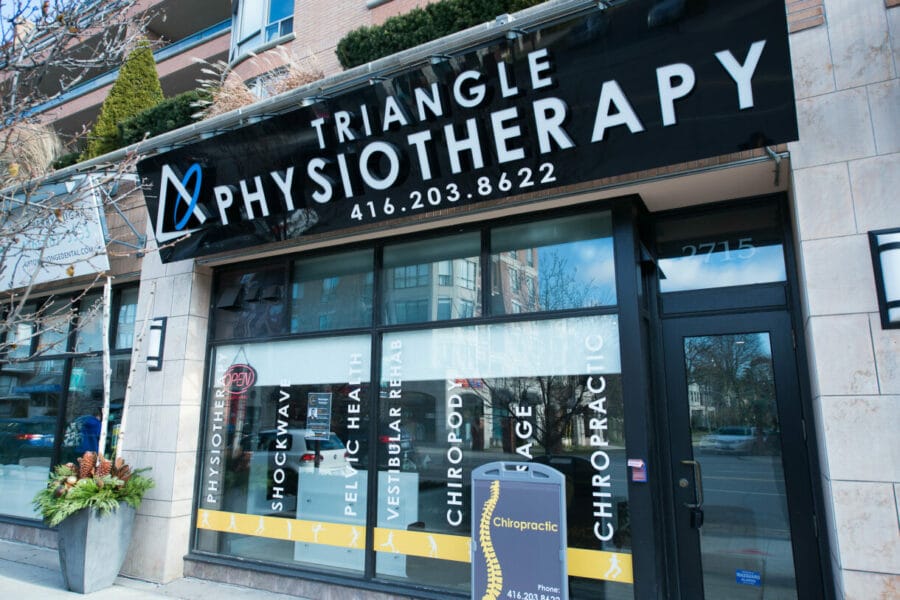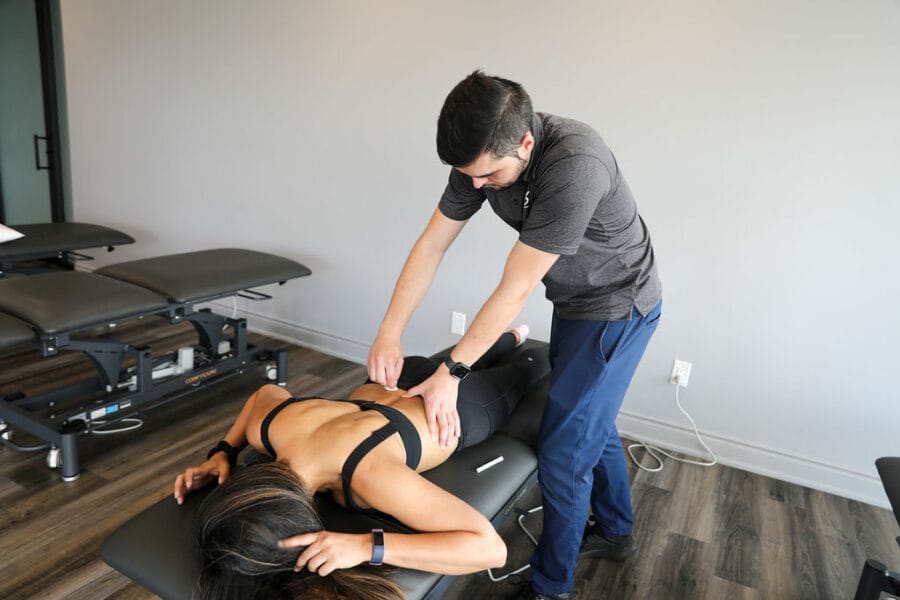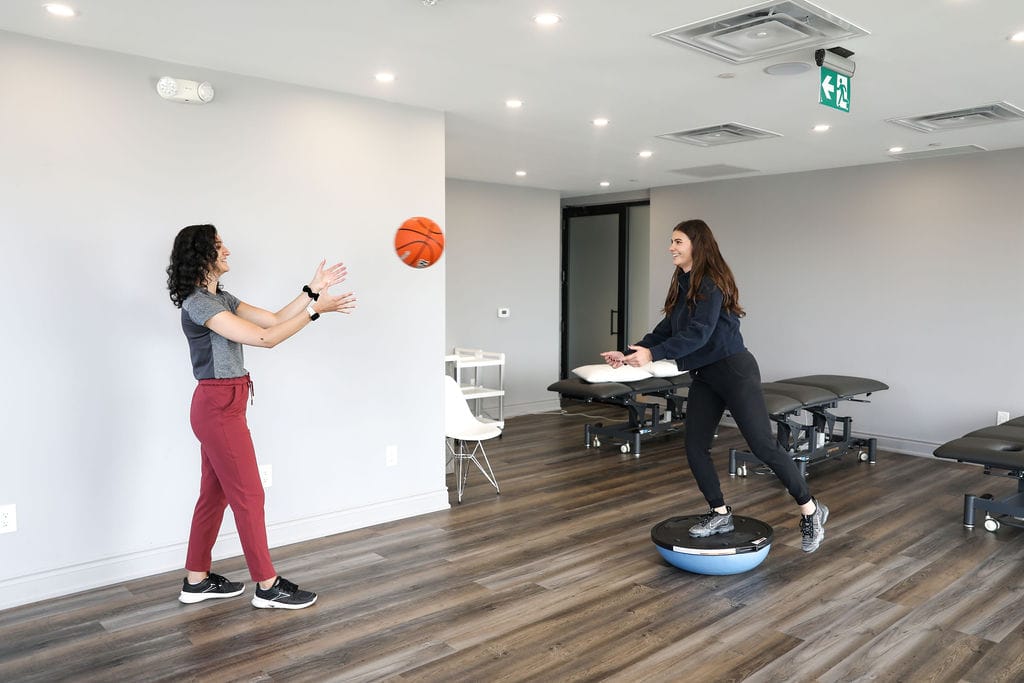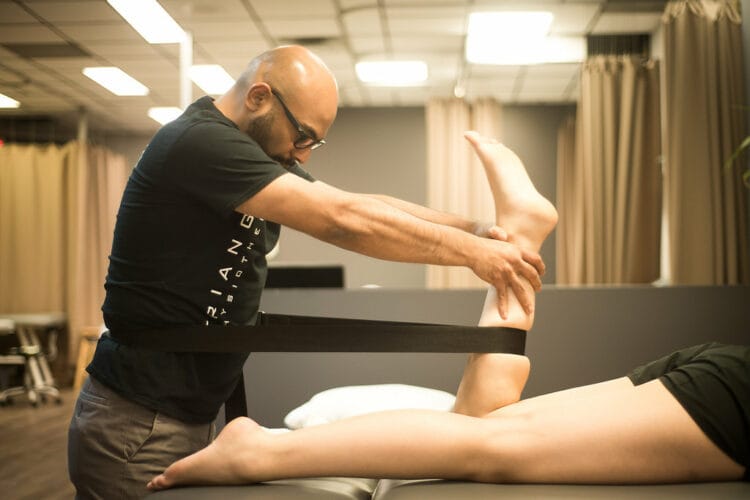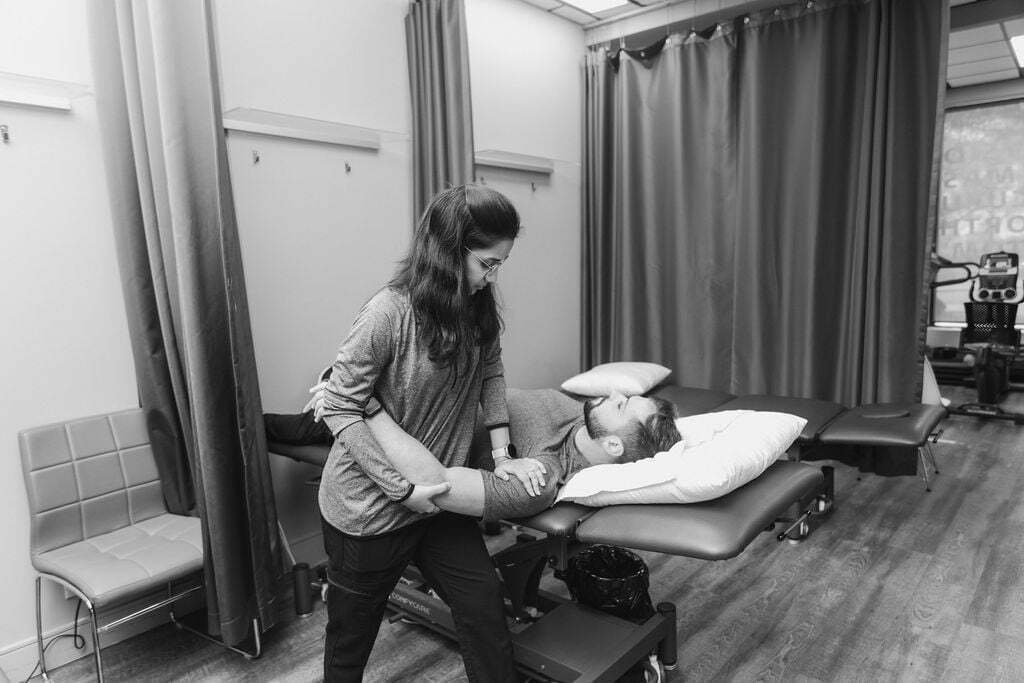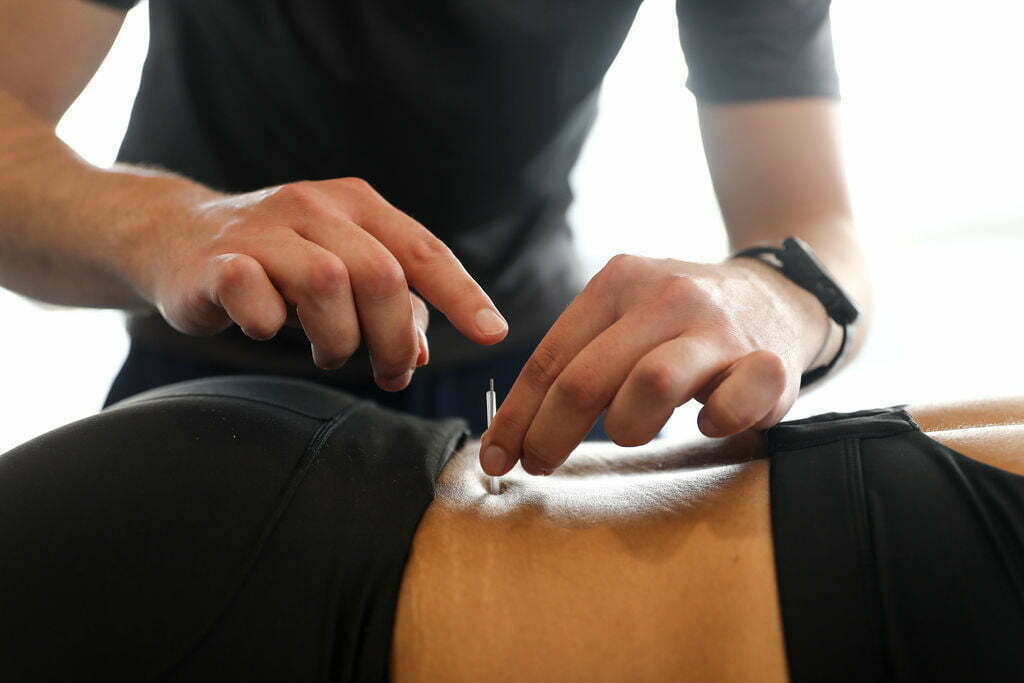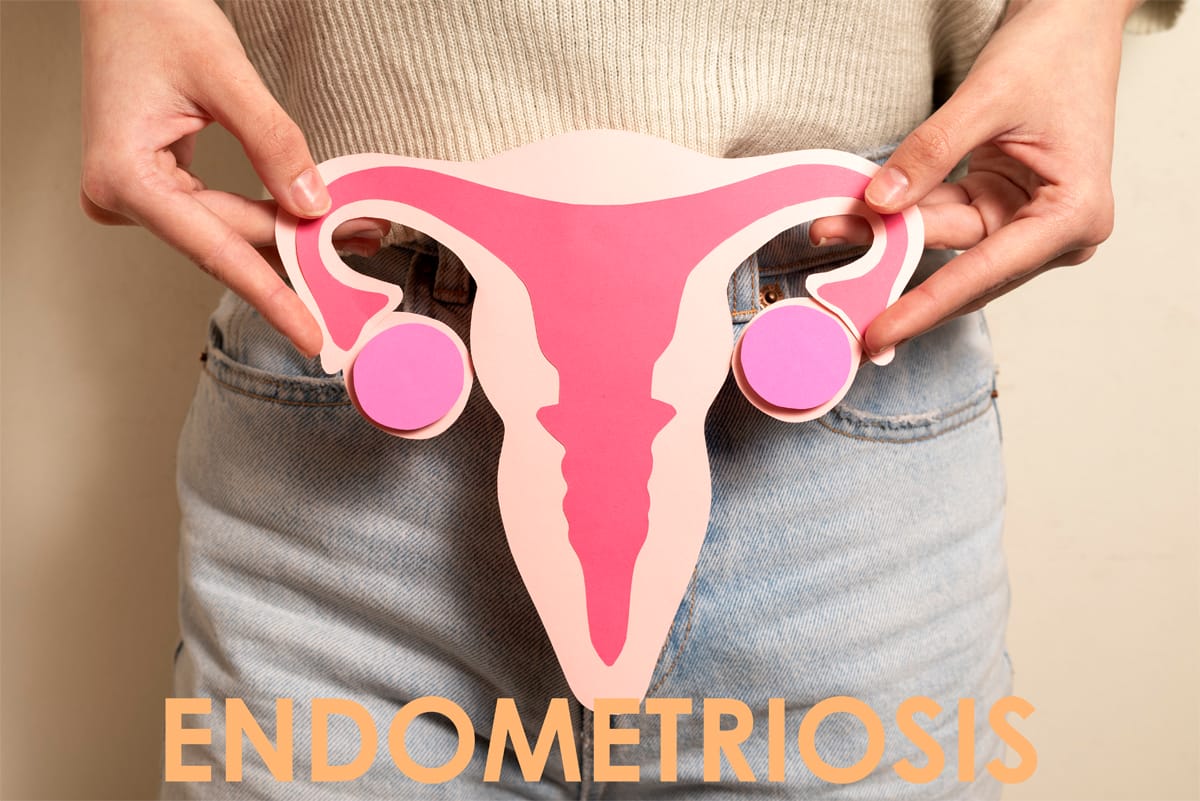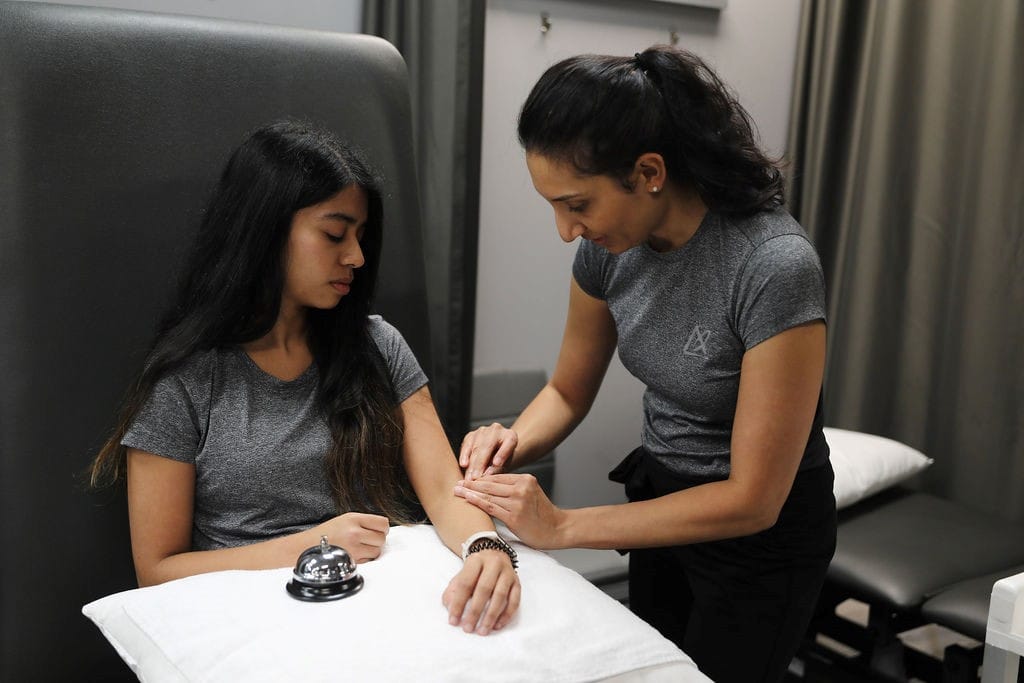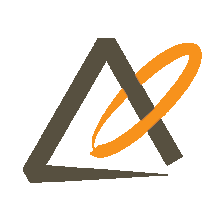How do I choose the Best Physiotherapist Near Me?

When choosing a physiotherapist, it’s essential to find someone who meets your specific needs and can provide high-quality care. Here are some steps you can take to help you pick the best physiotherapist:
- Ask for recommendations: Ask your friends, family, or colleagues for recommendations. Personal referrals can be valuable as they come from people you trust.
- Research their experience and specialization: Look for a physiotherapist with experience and expertise in treating your specific condition or injury. Physiotherapy covers a broad range of areas, such as sports injuries, post-surgery rehabilitation, back pain, or neurological disorders. Choosing someone who specializes in your area of concern can increase the chances of effective treatment.
- Check credentials and qualifications: Ensure that the physiotherapist you’re considering is licensed and registered to practice in Ontario. You can usually verify their credentials through the College of Physiotherapists of Ontario.
- Read reviews and testimonials: Search online for reviews or testimonials from previous patients. Although individual experiences may vary, reading about others’ experiences can give you an idea of the physiotherapist’s reputation and patient satisfaction.
- Assess communication and rapport: A good physiotherapist should listen and communicate well. They should be able to understand your concerns, explain your condition or treatment plan clearly, and answer any questions you may have. It’s important to feel comfortable and have a good rapport with your physiotherapist to ensure a positive therapeutic relationship.
- Consider practical factors: Take into account the location of the physiotherapy clinic or practice. It’s generally more convenient to choose a clinic that is easily accessible to you, whether it’s close to your home or workplace. Additionally, check their availability and scheduling options to see if they can accommodate your needs.
- Insurance coverage: If you have health insurance, check if the clinic provides direct billing to your insurance. This way you only have to pay a copayment or deductible if required by your plan.
- Initial Assessment: Schedule an initial assessment with the physiotherapist to discuss your condition, treatment options, and their approach. This can give you a sense of their knowledge, professionalism, and whether their treatment philosophy aligns with your goals.
What are the types of specializations that physiotherapists can have?
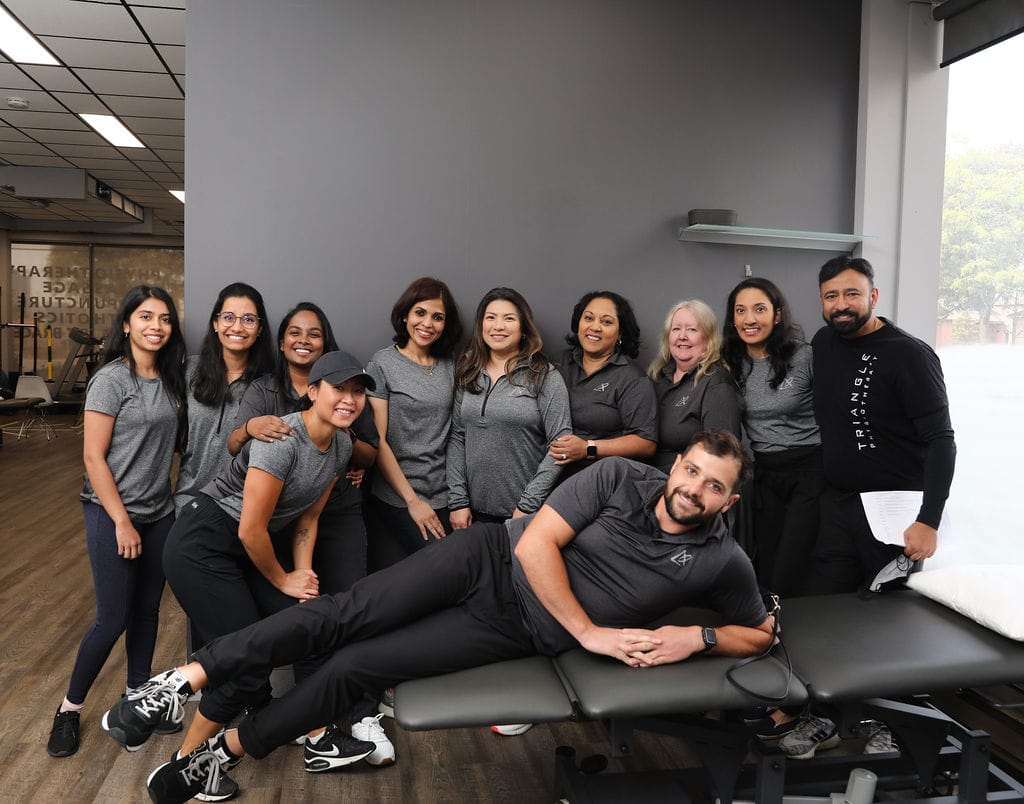
Physiotherapists have training in assessing, diagnosing, and treating a wide range of physical conditions and injuries. Physiotherapists can specialize in various areas of practice based on their interests, expertise, and advanced training. Some common specializations that our physiotherapists in Toronto have include:
- FCAMPT – The highest level of training in orthopedic manual therapy
- McKenzie Certification
- Cancer Rehab
- Pelvic Health – Assessing and treating pelvic floor conditions in men and women
- Vestibular Rehab & Concussion Therapy
- Running Assessments
- Sports Physiotherapy
These are just a few examples of the specializations within physiotherapy. It’s worth noting that some physiotherapists may have expertise in multiple areas or choose to focus on specific sub-specialties within these broader categories.
Our More Locations
Physiotherapy Etobicoke | Physiotherapy Oakville | Physiotherapy North York | Physiotherapy Toronto | Physiotherapy Lawrence Park | Physiotherapy Mississauga | Physiotherapy Queens Quay | Physiotherapy Mississauga Erin Mills | Physiotherapy Liberty Village
Click HERE to book an appointment with a physiotherapist at one of our eight locations.
- Physiotherapy Etobicoke – Triangle Physiotherapy Etobicoke
- Oakville Physiotherapy Clinic – Triangle Physiotherapy Oakville
- Physiotherapy North York – Triangle Physiotherapy North York
- Mississauga Physiotherapy Clinics – Triangle Physiotherapy Mississauga
- Downtown Physiotherapy Clinics – Triangle Physiotherapy King West
- Uptown Physiotherapy Clinics – Triangle Physiotherapy Lawrence Park
- Physiotherapy Clinic Downtown Toronto – Triangle Physiotherapy Queens Quay
- Physiotherapy Clinics Mississauga – Triangle Physiotherapy Erin Mills
“Choosing the best physiotherapist near you is crucial for effective treatment and recovery. Triangle Physiotherapy offers expert services across the GTA, including Physiotherapy in Etobicoke, Oakville, North York, Toronto, Lawrence Park, Queens Quay, Erin Mills, Mississauga, and Liberty Village. Our experienced team is dedicated to providing personalized care tailored to your needs, helping you achieve your health goals.”
Q: Why do I experience back pain while working from home?
A: Back pain during work from home can be caused by various factors. Some common reasons include:
- Poor posture,
- Inadequate ergonomics,
- Prolonged sitting,
- Lack of physical activity, and
- Stress
Working from home often means using suboptimal workstations, such as sitting on a couch or using a kitchen table as a desk, which can contribute to poor posture and strain on the back muscles.
Q: How can I improve my posture while working from home?
A: Improving your posture can help reduce back pain. Here are some tips:
- Use a comfortable chair with good lumbar support.
- Sit up straight and align your head, neck, and spine.
- Keep your feet flat on the floor or use a footrest if needed.
- Position your computer monitor at eye level to avoid straining your neck.
- Take breaks and stretch regularly to prevent prolonged sitting.
Q: What are some ergonomic recommendations for a home office setup?
A: Consider the following ergonomic recommendations for a home office setup:
- Invest in an adjustable chair with proper lumbar support.
- Use a desk or workstation at an appropriate height to maintain proper alignment.
- Position your keyboard and mouse at a comfortable distance and height.
- Ensure your computer monitor is at eye level and about an arm’s length away.
- Use a document holder if you frequently refer to papers or documents.
- Consider using an ergonomic keyboard and mouse to minimize strain on your hands and wrists.
Q: How can I incorporate physical activity into my work-from-home routine?
A: Adding physical activity to your work-from-home routine can help alleviate back pain. Here are some suggestions:
- Take short breaks every hour to stretch and move around.
- Incorporate exercises such as walking, jogging, or cycling into your daily routine.
- Consider using a standing desk or an adjustable desk converter that allows you to alternate between sitting and standing.
- Engage in exercises specifically targeting core strength and back muscles, like yoga or Pilates.
- Schedule regular exercise breaks or participate in online workout classes during your breaks.
Q: Are there any specific exercises that can help relieve back pain while working from home?
A: Yes, certain exercises can help relieve back pain. Here are a few examples:
- Cat and Camel
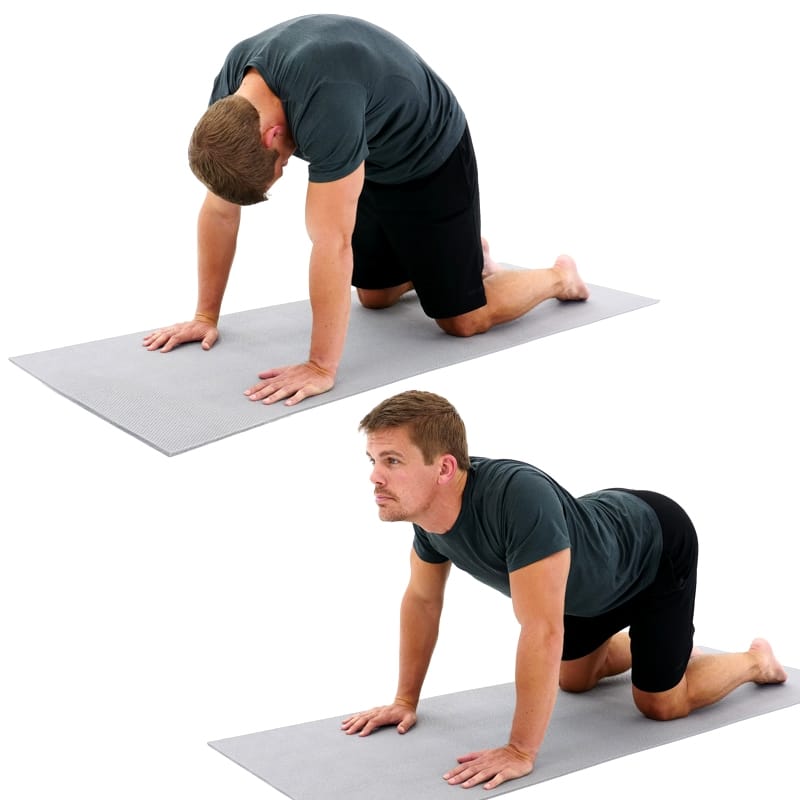
Get on your hands and knees, arch your back upward like a cat, then lower it down like a camel.
2. Back Extensions
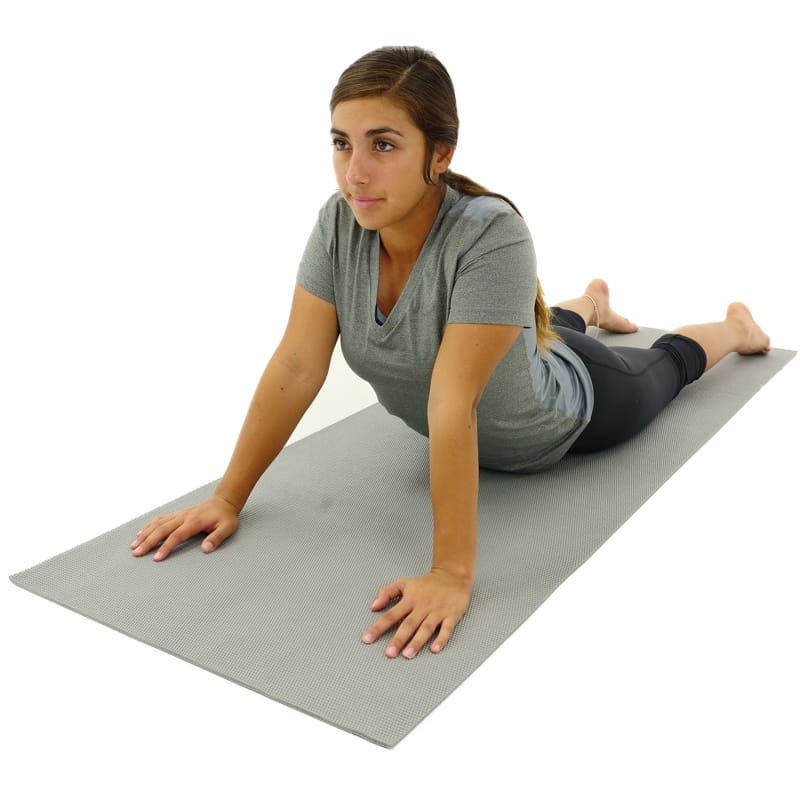
Lie face down, place your hands under your shoulders, and slowly lift your upper body off the ground while keeping your pelvis on the floor.
3. Bridge Pose
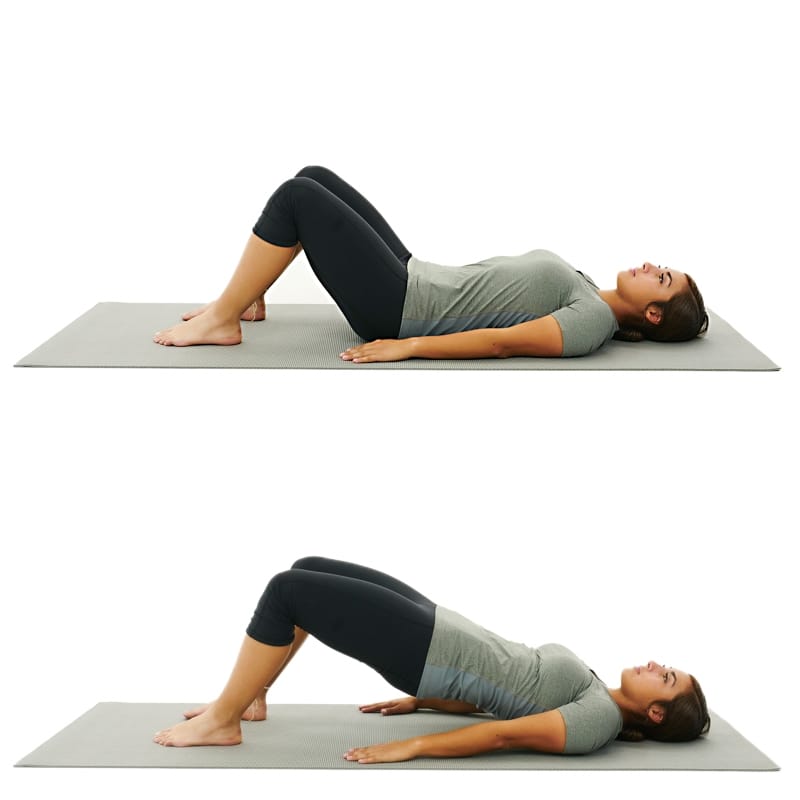
Lie on your back with your knees bent, feet flat on the floor. Lift your hips off the ground, forming a straight line from knees to shoulders.
4. Child’s Pose
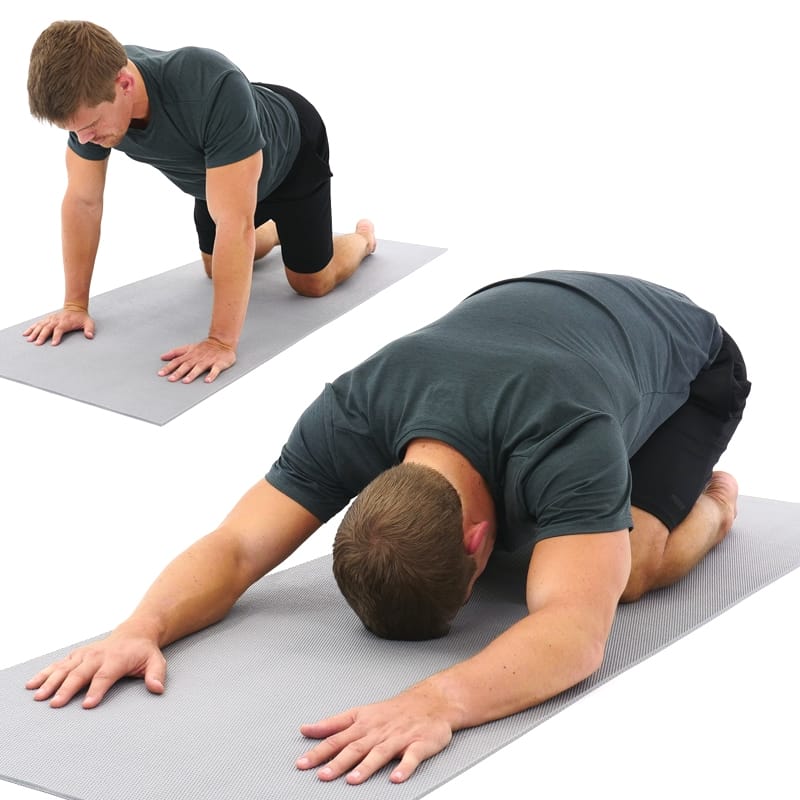
Kneel on the floor, then sit back on your heels while lowering your upper body forward, reaching your arms out in front of you.
Remember to consult with a physiotherapist for personalized advice on exercises and stretches for your specific condition.
Q: How can I manage stress-related back pain while working from home?
A: Stress can contribute to back pain. Here are some strategies to manage stress:
- Practice relaxation techniques such as deep breathing exercises, meditation, or mindfulness.
- Maintain a healthy work-life balance by setting clear boundaries between work and personal time.
- Engage in stress-reducing activities outside of work, such as hobbies, exercise, or spending time
Click HERE to book an appointment with a physiotherapist at one of our eight locations.
- Physiotherapy Etobicoke – Triangle Physiotherapy Etobicoke
- Oakville Physiotherapy Clinic – Triangle Physiotherapy Oakville
- Physiotherapy North York – Triangle Physiotherapy North York
- Mississauga Physiotherapy Clinics – Triangle Physiotherapy Mississauga
- Downtown Physiotherapy Clinics – Triangle Physiotherapy King West
- Uptown Physiotherapy Clinics – Triangle Physiotherapy Lawrence Park
- Physiotherapy Clinic Downtown Toronto – Triangle Physiotherapy Queens Quay
- Physiotherapy Clinics Mississauga – Triangle Physiotherapy Erin Mills
“Working from home can lead to back pain, but with the right strategies and physiotherapy, you can find relief. Triangle Physiotherapy offers expert services across the GTA, including Physiotherapy in Etobicoke, Oakville, North York, Toronto, Lawrence Park, Queens Quay, Erin Mills, Mississauga, and Liberty Village. Our experienced physiotherapists can help you develop a personalized plan to manage and prevent back pain while working from home.”
After a breast cancer diagnosis, many women are left to face new challenges caused by the side effects of their cancer treatments. While some side effects tend to disappear on their own over time, many side effects can have long-lasting physical and emotional consequences.
What are the common side effects of breast cancer treatment?
Breast surgery, such as a mastectomy, lumpectomy, or reconstruction, can cause many women to experience pain and physical limitations such as difficulty moving their arm, weakness, swelling, and scar tightness. In addition, some women may also develop pathologies such as post-mastectomy pain syndrome and axillary web syndrome following surgery.
Furthermore, both chemotherapy and radiation therapy also have their side effects, including fatigue, tingling, numbness in the hands/feet (chemotherapy-induced peripheral neuropathy), and radiation fibrosis, among many others.
These physical and psychological side effects of breast cancer treatments can significantly impact your daily functioning and independence both at home and at work. Research shows that both physiotherapy and exercise can help to alleviate many of these side effects and play an essential role in your recovery during and after breast cancer.
What are the benefits of breast cancer rehabilitation?
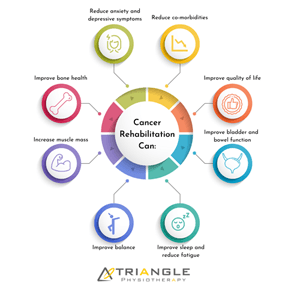
Physiotherapy interventions can help you to:
- Restore your arm movement
- Improve your shoulder, trunk, and abdominal strength
- Decrease your pain
- Improve your flexibility
- Improve your energy and endurance
- Reduce your risk of developing lymphedema
- Improve your posture and body awareness
In addition, exercise is also known to address many side effects, such as bone density issues related to hormonal medication, reducing your risk of developing lymphedema, and improving cancer-related fatigue in addition to also reducing your risk of reoccurrence. Physiotherapists are exercise specialists who will work with you to provide a safe and effective exercise program.
At Triangle, we are committed to helping women improve their health and well-being during each stage of their cancer recovery.
What are the components of breast cancer rehabilitation?
Every woman undergoing breast cancer treatment is different and hence will have unique rehabilitation needs. Your physiotherapist will use a combination of treatment techniques best suited for your condition. Interventions may include:
- Manual (hands-on) techniques such as soft-tissue mobilization and myofascial release to improve your flexibility and manage conditions such as radiation fibrosis and axillary web syndrome.
- Scar Massage
- Exercises to improve your shoulder movement and strength
- Exercises to improve your endurance and overall energy levels
- Individualized education regarding risk reduction and early detection of lymphedema
- Energy conservation techniques
- Education on how to return to physical activity
- Home exercise program
What are the most common misconceptions about Breast Cancer Rehabilitation?
There is a common misconception that for months or years after breast cancer surgery or radiation therapy, women should not use the arm on the affected side for lifting or working because they might get lymphedema or other problems. Research tells us this is FALSE, in fact with a proper physiotherapy program most women can achieve greater strength and function in the affected arm than what they had before surgery; with no increase in the chances of getting lymphedema.
Another misconception is that Breast Cancer Physiotherapy is the same as an exercise program. Physiotherapists are highly trained professionals able to independently diagnose and treat problems with pain or movement using a wide range of assessment methods and treatments, of which a specialized exercise program is one piece.
What does a typical session at Triangle Physiotherapy look like?
Your Physiotherapist will conduct a thorough assessment of the issue. This will include asking questions about your cancer treatment and the problems you’re having, other relevant medical information, and questions about your goals for therapy. They will do a physical assessment of the problem which could include assessing movements, strength and fitness, scar tissue, nerve function, and/or injuries from radiation or surgery. Your Physiotherapist will then clearly communicate all of their findings to you and describe their proposed treatment plan.
How many sessions will I need?
There is no one recipe for the number of treatment sessions or the length of time required for full recovery. Some conditions will require only a few sessions while others may require more intensive treatments and several sessions. Whatever your prognosis, your physiotherapist at Physiotherapy Oakville will clearly communicate expected timelines with you.
Joining Physiotherapy Oakville ensures you receive a personalized treatment plan based on scientific assessment and evidence-based practices. Research has shown that tailored physiotherapy programs can significantly enhance recovery outcomes. By understanding your specific needs and providing clear communication about your progress, the team at Physiotherapy Oakville helps you achieve optimal recovery in the most efficient timeframe.
What types of healthcare professionals can be involved in breast cancer rehabilitation at Triangle Physiotherapy?
Breast cancer rehabilitation is typically delivered by a multidisciplinary team of healthcare professionals. This team may include physiotherapists, acupuncturists, pelvic health physiotherapists, exercise specialists, nutritionists, and massage therapists.
Click HERE to book an appointment with a cancer rehab physiotherapist at one of our eight locations.
- Physiotherapy Etobicoke – Triangle Physiotherapy Etobicoke
- Oakville Physiotherapy Clinic – Triangle Physiotherapy Oakville
- Physiotherapy North York – Triangle Physiotherapy North York
- Mississauga Physiotherapy Clinics – Triangle Physiotherapy Mississauga
- Downtown Physiotherapy Clinics – Triangle Physiotherapy King West
- Uptown Physiotherapy Clinics – Triangle Physiotherapy Lawrence Park
- Physiotherapy Clinic Downtown Toronto – Triangle Physiotherapy Queens Quay
- Physiotherapy Clinics Mississauga – Triangle Physiotherapy Erin Mills
“Rehabilitation after breast cancer treatment is crucial for regaining strength and improving quality of life. Triangle Physiotherapy offers expert services across the GTA, including Physiotherapy in Etobicoke, Oakville, North York, Toronto, Lawrence Park, Queens Quay, Erin Mills, Mississauga, and Liberty Village. Our experienced physiotherapists provide personalized care to help you recover and thrive after breast cancer treatment.”
One of the most common questions we are asked over the phone is “How Much Does Physiotherapy Cost?”. The cost of physiotherapy can vary depending on various factors such as the location, the specific clinic or facility, the experience and expertise of the physiotherapist, and the type and duration of treatment required. Additionally, the healthcare system and insurance coverage in your province can also affect the cost.
That being said, the fees for physiotherapy in the Greater Toronto Area range from $125 to $145 for the initial assessment and from $85 to $105 for follow-up sessions.
What type of facilities provide physiotherapy services in Ontario?
Physiotherapy services are available at many facilities in the community.
- Private Clinics like Triangle Physiotherapy where people of all ages can receive care.
- Hospitals – As per the Ontario Physiotherapy Association, Physiotherapy in hospitals may be provided to in-patients staying in a hospital or in an outpatient clinic. Many outpatient clinics offer rehabilitation programs for people recovering from surgery, stroke, or an injury. Not all hospitals in Ontario have an outpatient physiotherapy program or physiotherapy services that will meet your specific needs.
- Home Care – Physiotherapy services may be delivered in your home whether you live in a house or condo, or in a larger facility such as a retirement home.
- Long-Term Care Homes – Physiotherapy services are available to residents of Long-Term Care homes
- Community Physiotherapy Clinics, also known as OHIP clinics – Patients who qualify receive an ‘episode of care’ for their condition/diagnosis. Each episode of care includes the assessment, treatment, and discharge summary. The patient cannot be charged for these services. To be eligible for physiotherapy services at a Community Physiotherapy Clinic, a patient must, for each episode of care: have a physician’s or nurse practitioner’s referral for physiotherapy services and fall within one of the following categories:
- 19 years old or younger, or;
- 65 years old or older, or;
- Are receiving benefits under the Ontario Disability Support Program or Ontario Works, or;
- Have been overnight in a hospital for a condition that now requires physiotherapy treatment.
Who pays for physiotherapy services?
At private clinics like Triangle Physiotherapy, physiotherapy may be covered by the following:
- Extended Health Plans provided by employers or self-purchased
- WSIB – if injured at work
- Auto Insurance – Motor Vehicle Accident
- Interim Federal Health Program – for Refugees
- Self-pay
Can I claim physiotherapy on my income tax in Canada?
You can claim out-of-pocket physiotherapy as a medical expense tax credit. Save all your receipts from your physiotherapy visits. Please speak to your accountant for more details.
How do I book an appointment to see a physiotherapist?
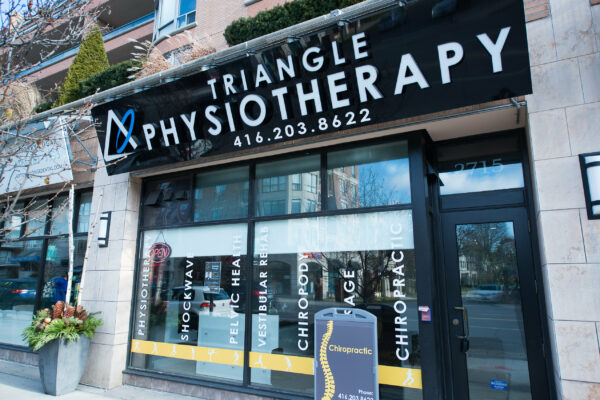
Our More Locations
Physiotherapy Etobicoke | Physiotherapy Oakville | Physiotherapy North York | Physiotherapy Toronto | Physiotherapy Lawrence Park | Physiotherapy Mississauga | Physiotherapy Queens Quay | Physiotherapy Mississauga Erin Mills | Physiotherapy Liberty Village
Click HERE to book an appointment with a physiotherapist at one of our eight locations.
- Physiotherapy Etobicoke – Triangle Physiotherapy Etobicoke
- Oakville Physiotherapy Clinic – Triangle Physiotherapy Oakville
- Physiotherapy North York – Triangle Physiotherapy North York
- Mississauga Physiotherapy Clinics – Triangle Physiotherapy Mississauga
- Downtown Physiotherapy Clinics – Triangle Physiotherapy King West
- Uptown Physiotherapy Clinics – Triangle Physiotherapy Lawrence Park
- Physiotherapy Clinic Downtown Toronto – Triangle Physiotherapy Queens Quay
- Physiotherapy Clinics Mississauga – Triangle Physiotherapy Erin Mills
“Understanding the cost of physiotherapy is essential when planning your care. Triangle Physiotherapy offers expert services across the GTA, including Physiotherapy in Etobicoke, Oakville, North York, Toronto, Lawrence Park, Queens Quay, Erin Mills, Mississauga, and Liberty Village. Our clinics provide transparent pricing and personalized treatment plans to ensure you receive the best care at a cost that suits your needs.”
Physiotherapy, also known as physical therapy, is a healthcare profession that focuses on the treatment and prevention of physical disabilities, injuries, and pain through exercise, manual therapy, and other modalities.
Here are the top 10 frequently asked questions and answers about physiotherapy:
What does a physiotherapist do?
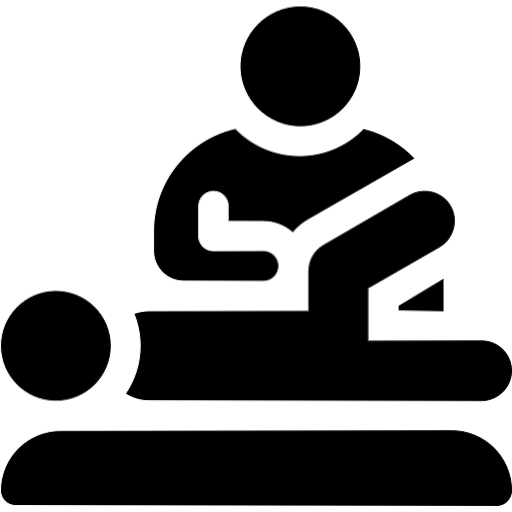
A physiotherapist diagnoses and treats a wide range of conditions affecting the musculoskeletal, neurological, and cardiovascular systems. They develop personalized treatment plans that may include exercises, manual therapy, electrotherapy, and other techniques to help patients recover from injuries or manage chronic conditions. Some Physiotherapists also have specialization in pelvic health, vestibular rehab, concussion management, and pediatrics. Physiotherapists are known to be advocates of movement and good health in the community.
What are the benefits of physiotherapy?

Physiotherapy can help improve mobility, strength, and flexibility, reduce pain and inflammation, prevent injury, and improve overall quality of life. It can also help people recover from surgeries or illnesses and manage chronic conditions such as arthritis, back pain, and stroke.
What conditions can physiotherapy treat?

Physiotherapy can treat a variety of conditions, including but not limited to musculoskeletal injuries such as sprains and strains, post-surgery rehabilitation, neurological conditions such as stroke and Parkinson’s disease, respiratory conditions such as asthma and chronic obstructive pulmonary disease (COPD), and chronic pain syndromes such as fibromyalgia. They can also treat pelvic floor dysfunction, incontinence, and other pelvic floor issues. Vertigo (BPPV) is another condition that some physiotherapists are trained in. Check out the detailed list of conditions on our website.
How long does a physiotherapy session last?

The initial assessment with a physiotherapist at our clinic is an hour long. Follow-up sessions are usually 30 minutes but some people may need longer sessions depending on their condition and treatment plan.
How many physiotherapy sessions will I need?

The number of physiotherapy sessions required varies depending on the condition being treated, the severity of the injury, and the patient’s individual needs. Our physiotherapist will work with the patient to develop a personalized treatment plan and will provide an estimate of the number of sessions needed.
Is physiotherapy painful?

Physiotherapy may involve some discomfort during treatment, especially if the patient is recovering from an injury. However, a physiotherapist will work within the patient’s pain threshold and provide techniques to manage any discomfort. The key is to communicate with your physiotherapist during your treatment session so they can adjust their treatment to keep you comfortable.
Do I need a physician’s referral to see a physiotherapist?

Physiotherapy is primary care in Ontario, so we do not need a referral to see you. However, if you will be claiming your treatments through a benefits plan, it would be best to check with your insurance about their referral requirements. If you will be visiting an OHIP clinic, you will most certainly need a physician’s referral to be covered. See OHIP-covered physiotherapy requirements here.
How do I choose a physiotherapist?

When choosing a physiotherapist, consider their qualifications, experience, and area of expertise. It may also be helpful to read online reviews and ask for recommendations from friends and family. Triangle Physiotherapy has 3000+ 5-Star Google reviews between all eight locations. We pride ourselves on the service we provide and our physiotherapists have a learning mindset so they are always learning new skills.
Is physiotherapy covered by insurance?

Most insurance plans cover physiotherapy, but coverage can vary depending on the plan and the specific services provided. It’s important to check with your insurance provider to determine your coverage.
Our More Locations
Physiotherapy Etobicoke | Physiotherapy Oakville | Physiotherapy North York | Physiotherapy Toronto | Physiotherapy Lawrence Park | Physiotherapy Mississauga | Physiotherapy Queens Quay | Physiotherapy Mississauga Erin Mills | Physiotherapy Liberty Village
How do I book an appointment to see a physiotherapist?
Click HERE to book an appointment with a physiotherapist at one of our eight locations.
- Physiotherapy Etobicoke – Triangle Physiotherapy Etobicoke
- Oakville Physiotherapy Clinic – Triangle Physiotherapy Oakville
- Physiotherapy North York – Triangle Physiotherapy North York
- Mississauga Physiotherapy Clinics – Triangle Physiotherapy Mississauga
- Downtown Physiotherapy Clinics – Triangle Physiotherapy King West
- Uptown Physiotherapy Clinics – Triangle Physiotherapy Lawrence Park
- Physiotherapy Clinic Downtown Toronto – Triangle Physiotherapy Queens Quay
- Physiotherapy Clinics Mississauga – Triangle Physiotherapy Erin Mills
“Physiotherapy plays a crucial role in improving mobility, managing pain, and enhancing overall health. Triangle Physiotherapy offers expert services across the GTA, including Physiotherapy in Etobicoke, Oakville, North York, Toronto, Lawrence Park, Queens Quay, Erin Mills, Mississauga, and Liberty Village. Our experienced physiotherapists provide personalized care to help you achieve your physical health goals.”
One of the most common questions that we are asked by patients calling our clinic is “Will OHIP cover my treatment?” or “Is physiotherapy covered by OHIP?”.
The answer is: It is covered by OHIP but in particular circumstances. Continue to read to get more information on if and when OHIP covers physiotherapy treatments.
Who is eligible to get OHIP-funded physiotherapy treatments?
With a valid OHIP card you can receive government-funded physiotherapy if you are:
- 65 years or older
- 19 years or under
- any age after an overnight hospital stay (within the last 12 months) for a condition requiring physiotherapy
- a recipient of the Ontario Works or the Ontario Disability Support Program (any age, OHIP card not required)
Remember, you have to have a referral from a doctor or nurse practitioner in addition to any of the above criteria.
Does ODSP cover physiotherapy?
You may be covered for physiotherapy under the ODSP program at an OHIP funded clinic. Contact your ODSP administrator for more information.
Where can I go to get OHIP-covered physiotherapy treatments?
The answer to your question, “Does OHIP cover physiotherapy?” is yes – OHIP covers physiotherapy ONLY at designated government-funded physiotherapy clinics and you have to meet some eligibility criteria. Not all clinics are able to provide OHIP-funded physiotherapy treatments.
Does OHIP cover physiotherapy for seniors?

Seniors over 65 years of age are covered for physiotherapy treatments provided all the eligibility criteria are met. However, you should read on for the disadvantages of visiting an OHIP-funded clinic.
Do I need a doctor’s referral to get treatment at an OHIP-funded physiotherapy clinic?
You need a referral from a doctor or nurse practitioner once you have met the eligibility criteria. This ensures that your condition is appropriately assessed and that you receive the most suitable treatment plan.
At Physiotherapy Oakville, we work closely with healthcare professionals to provide seamless and comprehensive care. Scientific studies emphasize the importance of coordinated care in achieving optimal health outcomes. By joining Physiotherapy Oakville, you gain access to a network of experts dedicated to your well-being, ensuring that your treatment is both effective and tailored to your specific needs. Our team will guide you through the referral process and collaborate with your healthcare provider to develop a personalized physiotherapy plan.
Is Triangle Physiotherapy an OHIP-funded physiotherapy clinic?
Triangle Physiotherapy is not an OHIP-funded physiotherapy clinic. Physiotherapy at Triangle is funded by the following:
- Extended Health Insurance Plans
- WSIB
- Auto Insurance if you have been in an accident
- Private pay
- Veterans Affairs Canada
We have physiotherapy clinics in Etobicoke, physiotherapy clinics in Oakville, physiotherapy clinics in Mississauga, physiotherapy clinics in North York and physiotherapy clinics in Toronto.
What are the disadvantages of going to an OHIP-funded physiotherapy clinic? 😞
While the biggest plus of going to an OHIP-funded physiotherapy clinic is that it is free, the eligibility criteria rule out most of us.
The disadvantages of getting treated at a government-funded clinic are:
- Wait times – the likelihood of you getting in to see a physiotherapist urgently is very low.
- Locations – the closest government-funded clinic might be an inconvenient distance away
- Over-booked schedule – the OHIP-funded clinics are reimbursed at a meager rate for each session, meaning that physiotherapists in OHIP-funded clinics can be double or even triple-booked in a single time slot. In addition, some clinics also do group sessions.
- Non-personal, non-individualized care – you may not see a physiotherapist for several sessions after your initial visit and be treated by a physiotherapy assistant.
What are the advantages of coming to Triangle Physiotherapy over going to an OHIP-funded physiotherapy clinic?
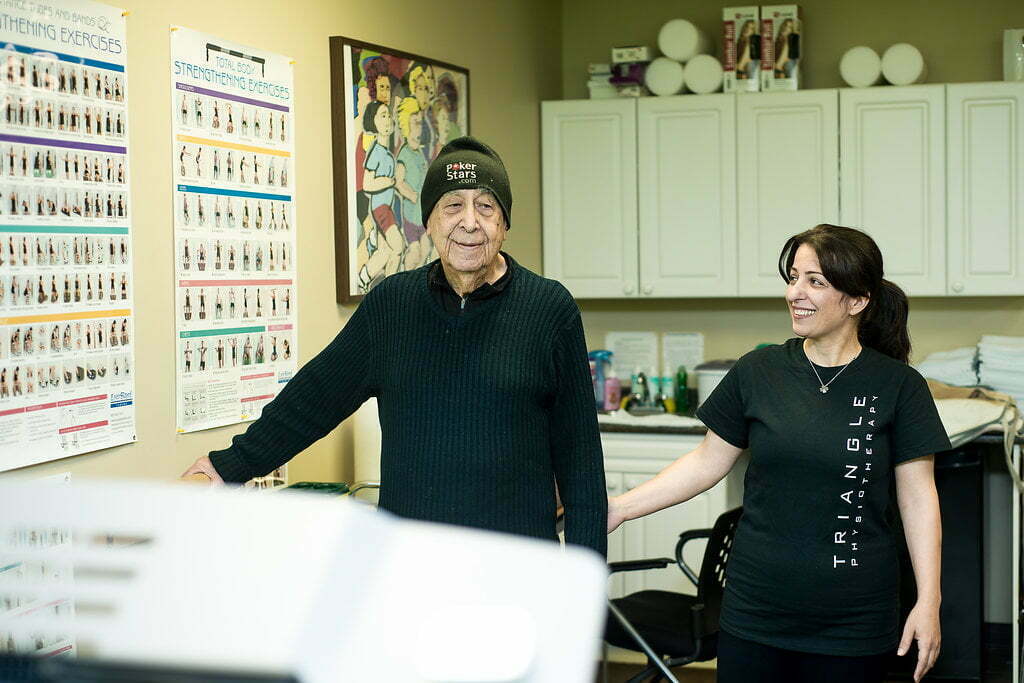
There are many advantages to seeing a physiotherapist at Triangle Physiotherapy over visiting an OHIP-funded clinic for treatment.
- Detailed one-hour assessment.
- One-on-one follow-up sessions – no group sessions or sessions with a PTA.
- Qualified physiotherapists with specializations in manual therapy, acupuncture, pelvic health, vestibular health, and more.
- In most cases, a doctor’s referral is not required. However, if you will be submitting your claim to an extended health plan, it is best to check if they require one.
- Convenient billing options – direct billing to insurance, pay by credit or debit card.
- Easily accessible locations.
- Best possible patient experience.
- Multi-disciplinary care – Massage Therapy, Chiropractic, Naturopathy, Chiropody.
- Morning, evening, and weekend appointments to suit your schedule.
Where can I find a great physiotherapist near me?
We have 8 convenient locations with physiotherapists to help you.
- Physiotherapy Etobicoke – Triangle Physiotherapy Etobicoke
- Oakville Physiotherapy Clinic – Triangle Physiotherapy Oakville
- Physiotherapy North York – Triangle Physiotherapy North York
- Mississauga Physiotherapy Clinics – Triangle Physiotherapy Mississauga
- Downtown Physiotherapy Clinics – Triangle Physiotherapy King West
- Uptown Physiotherapy Clinics – Triangle Physiotherapy Lawrence Park
- Physiotherapy Clinic Downtown Toronto – Triangle Physiotherapy Queens Quay
- Physiotherapy Clinics Mississauga – Triangle Physiotherapy Erin Mills
Book an appointment to see a physiotherapist in Toronto today!
“Understanding whether OHIP covers your physiotherapy treatment is crucial for planning your care. Triangle Physiotherapy offers expert services across the GTA, including Physiotherapy in Etobicoke, Oakville, North York, Toronto, Lawrence Park, Queens Quay, Erin Mills, Mississauga, and Liberty Village. Our team can help you navigate your insurance options and provide the care you need, whether or not it’s covered by OHIP.”
What is Acupuncture?
Acupuncture is an ancient, safe and effective alternative to medication and, in some cases, surgery. It stimulates the release of endorphins – the body’s natural pain-relieving neuro-hormones – through the insertion of needles into specific anatomical points (acupuncture points) to encourage natural healing.
What conditions can be treated with Acupuncture?
- Back/Neck pain
- Rotator Cuff Strain
- Knee Injuries
- Plantar Fasciitis
- Arthiritis
- Headaches
- Tennis/Golfer’s Elbow
- Achilles Tendinitis
- Ankle Sprain
- Bursitis
Does acupuncture hurt?
Acupuncture is a gentle treatment. Most patients find that the treatments are relaxing and cause minimal discomfort. Acupuncture needles are very fine, metallic, and as thin as a hair, making them quite painless upon insertion. Everyone experiences acupuncture differently, but most feel no pain or very minimal pain as the needles are inserted. You may experience a mild aching sensation or warmth around the needle site.
What is Dry Needling?
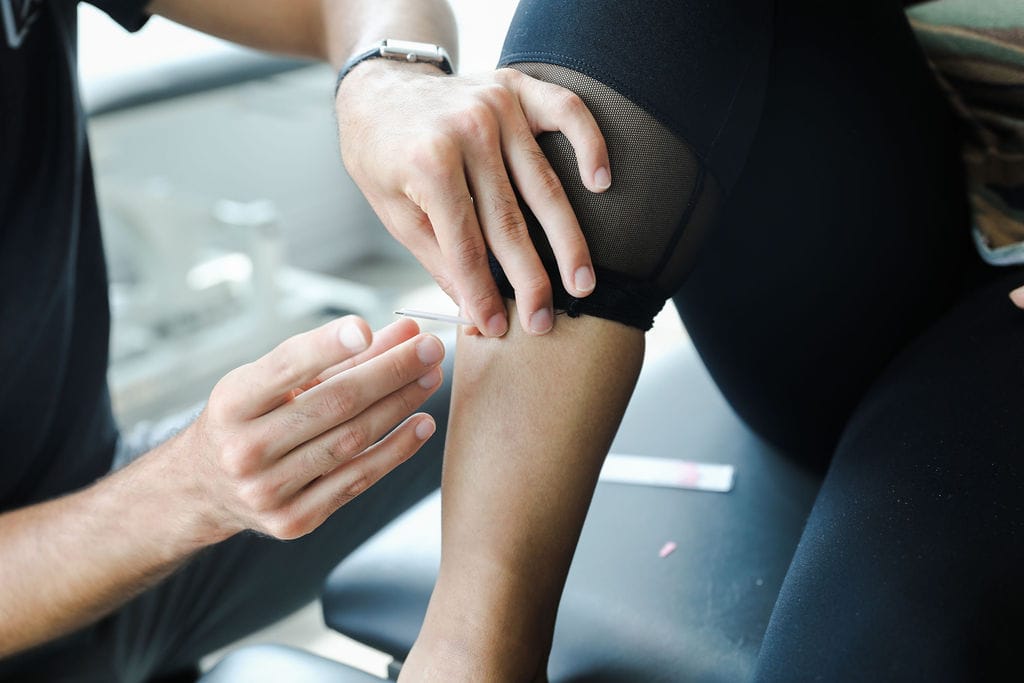
Dry Needling (DN) involves using a sterile needle to stimulate the motor point of the muscle. DN is also used on trigger points, or “knots”, that people sometimes feel in their muscles. This stimulation causes an involuntary twitch response, which helps to deactivate the tight muscle and allows it to loosen up.
What conditions can be treated with
Dry Needling?
- Rotator cuff tendonitis,
- Lateral epicondylitis (Tennis Elbow),
- Medial epicondylitis (Golfer’s Elbow),
- Piriformis tightness,
- Cervicogenic headaches,
- Low back pain,
- Repetitive stress injuries, and many more!
Does dry needling hurt?
Generally, the insertion of the needle is not felt. The local “twitch response” may provoke a brief pain sensation that has been described as a tingling, aching or cramping sensation.
Are there any side effects to Dry Needling?
Side effects may vary among individuals. Typically, only mild muscle soreness or skin bruising. Your physiotherapist will educate you on the benefits and side effects of dry needling prior to performing the technique on you.
Can physiotherapists and chiropractors perform acupuncture and dry needling?
Yes, physiotherapists, chiropractors, RMTs and naturopaths that have training in acupuncture can perform this technique in a safe an effective manner.
Our More Locations
Physiotherapy Etobicoke | Physiotherapy Oakville | Physiotherapy North York | Physiotherapy Toronto | Physiotherapy Lawrence Park | Physiotherapy Mississauga | Physiotherapy Queens Quay | Physiotherapy Mississauga Erin Mills | Physiotherapy Liberty Village
Book an appointment with a practitioner that does dry needling to get help with your condition.
“Choosing between dry needling and acupuncture depends on your specific needs and treatment goals. Triangle Physiotherapy offers expert services across the GTA, including Physiotherapy in Etobicoke, Oakville, North York, Toronto, Lawrence Park, Queens Quay, Erin Mills, Mississauga, and Liberty Village. Our experienced therapists can help you determine which treatment is right for you, providing personalized care to address your pain and enhance your well-being.”
By Roshni Ravi, Pelvic Health Physiotherapist
Endometriosis is a condition in which the tissue that lines the uterus grows outside of it, on other organs or structures in the pelvic cavity. This tissue, called endometrium, acts just like the lining of the uterus and thickens, breaks down, and bleeds with each menstrual cycle. However, because this tissue is located outside of the uterus, it has no way to exit the body, which can lead to pain, heavy bleeding, and the formation of scar tissue and adhesions. Endometriosis can also affect fertility.
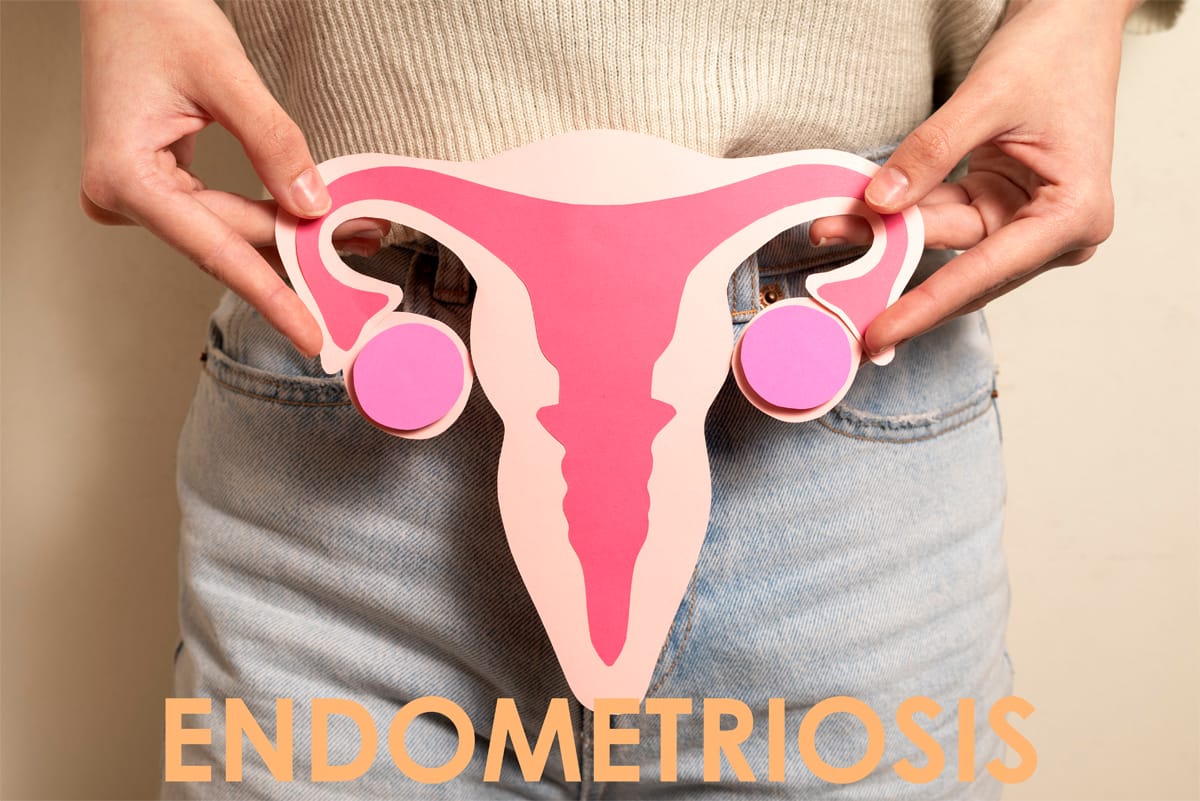
What is Endometriosis?
The cause of endometriosis is not well understood. It is usually treated with hormones, pain medication, and surgery. The average delay from symptom onset to diagnosis is 5.4 years in Canada, because of the uncertain etiology. Patients wait for an average of 3.1 years from the onset of symptoms to seeking consultation with their physician.
Some causes for endometriosis may possibly include:
- Retrograde menstruation: some of the endometrial tissue flows backwards through the Fallopian tubes and into the pelvic cavity, and attaches to other organs and structures.
- Embryonic cell growth: develops from cells in the embryonic stage that grow into endometrial tissue instead of into other tissue types
- Immune system dysfunction: some women may have a dysfunction in their immune system that allows endometrial tissue to grow outside the uterus
- Hormonal factors: hormonal imbalances contribute to the development of endometriosis
- Genetic factors
So what can I do about it?
Medical treatment includes surgery, hormonal therapy and medicated pain management. Other alternatives are acupuncture, herbal supplements and pelvic floor physiotherapy.
Pelvic floor physiotherapy can be beneficial for endometriosis. It can help alleviate pain, improve mobility and flexibility as well as reduce the formation of adhesions and scar tissue. Treatment targets the muscles and soft tissue in the pelvic area through techniques such as manual therapy, trigger point release and myofascial release to relax the muscles and thereby alleviate pain. There are a variety of pelvic floor exercises that can also contribute towards alleviating pain and improving symptoms.
Unsure of what to do next but experiencing these symptoms? Consult a pelvic health physiotherapist to see if pelvic floor physiotherapy is right for you. Our Mississauga Pelvic Health Physiotherapists are experienced and qualified to help you through this diagnosis. Book an appointment here.
Disclaimer: This article is for informational purposes only and should not be used for self-diagnosis.
“Recognizing the early signs of endometriosis is crucial for effective management and care. Triangle Physiotherapy offers expert pelvic health services across the GTA, including Physiotherapy in Etobicoke, Oakville, North York, Toronto, Lawrence Park, Queens Quay, Erin Mills, Mississauga, and Liberty Village. Our experienced physiotherapists provide personalized treatment plans to help you manage endometriosis symptoms and improve your quality of life.”
Golfer’s elbow and Tennis Elbow are both tendonitis. The difference is Golfer’s elbow occurs on the inner side of the elbow while Tennis Elbow occurs on the outer side of the elbow. Tennis elbow, also known as lateral epicondylitis is the inflammation of the tendon that connects the forearm muscles to a bony prominence on the outside of the elbow known as the lateral epicondyle. Golfer’s elbow, on the other hand, is known as medial epicondylitis because the inflammation is on the tendons which are attached to the medial epicondyle.
How Is Tennis Elbow Diagnosed?
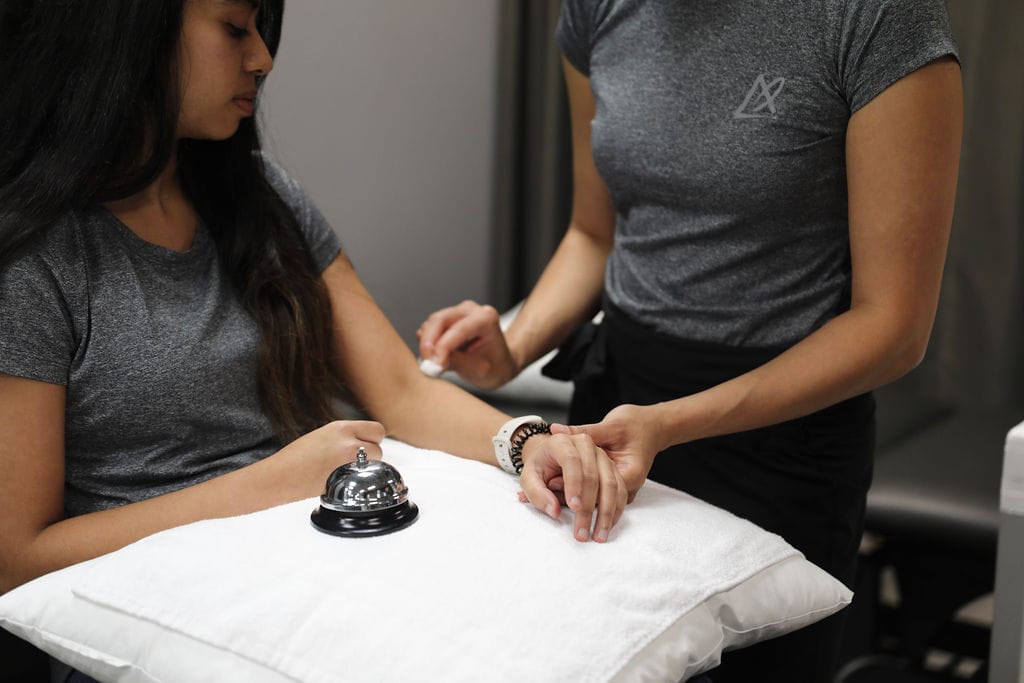
Your physiotherapist will evaluate tennis elbow by reviewing your medical history, performing and reviewing your medical history. A doctor may recommend a X-ray, EMG or MRI to assess the severity of the condition.
A physiotherapist can also conduct a detailed assessment of your elbow and the surrounding structures in order to create a personalized treatment plan for you. Special tests such as Cozen’s and Mills Test can also be used to diagnose Tennis elbow.
What are the complications of a Tennis Elbow?
Complications of Tennis elbow or lateral epicondylitis may include tendon rupture, recurrence of the injury, chronic pain, nerve entrapment in the forearm, and failure to improve despite both nonsurgical and no surgical treatment.
Cause of Tennis Elbow and Treatment
What causes a Tennis elbow and who might get a Tennis Elbow?
Some causes of Tennis elbow are:
- weak wrist muscles,
- use of tennis racquets that are too short,
- weakened muscles of the shoulder and wrist,
- repetitive hand motions,
- poor tennis technique,
- frequent use of hand tools,
- lifting heavy objects, and
- excessive gripping activities.
Despite the name, Tennis elbow is not only for tennis players although they tend to often develop tennis elbow because of the repetitive muscle use and gripping activities the sport entails. People whose professions involve repetitive use of the wrist and forearm are more likely to develop lateral epicondylitis.
Some professions, such as painters, dentists, plumbers, carpenters, musicians, and cooks, may develop Tennis elbow which can also be caused by the repetitive use of a keyboard and mouse.
What Is The Best Treatment For Tennis Elbows?
The majority of tennis elbow cases can be successfully treated without surgical intervention. How a tennis elbow is treated may vary depending on which medical professional you choose to see.
Research has shown that physiotherapy is the most effective treatment of the Tennis elbow.
Tennis Elbow Physiotherapy Treatment
- Therapeutic Ultrasound
- Acupuncture
- Tennis elbow treatment exercises
- Deep tissue massage
- Shockwave therapy
- Taping or brace
- TENS
- Modified activities
- Hot and cold packs
How does massage help heal Tennis elbow?
Tennis Elbow Massage Treatment helps improve circulation, stimulate collagen production, and increases mobility in the affected area.
What Can I Do To Prevent Tennis Elbow?
There are many ways to prevent Tennis elbow such as:
- Stretching regularly.
- Strengthening of the forearm muscles.
- Modifying activities that contribute to pain.
- Warming up before playing tennis and other sports and ensuring the stability of the wrist.
What are some Tennis elbow exercises which can be done at home to help prevent recurrence?
Specific Tennis elbow exercises to strengthen as well as stretch the muscles that are attached to the injured tendon will certainly help speed up healing which then increases its resistance to repetitive stress… Some of these Tennis elbow treatment exercises are Stress ball squeeze, finger stretch, wrist extension, flexion stretch, forearm extension, flexion, supination, and pronation strengthening exercises.
Are there any natural Tennis elbow treatments I can do at home while I wait to see a physiotherapist?
Resting and avoiding activities that aggravate your pain can be beneficial. You may also try to apply an ice pack for 15 mins three times a day.
What is the best treatment for chronic Tennis elbow?
The most effective treatment for chronic tennis elbow has always been physiotherapy and exercise. If physiotherapy does not fully heal it, however, steroid injections, braces, and surgery may also help.
Our physiotherapists in Toronto, Midtown Toronto, Mississauga, North York and Oakville can help you with tennis elbow. Book your appointment here.
“Effectively treating tennis elbow and golfer’s elbow requires specialized physiotherapy care. Triangle Physiotherapy offers expert services across the GTA, including Physiotherapy in Etobicoke, Oakville, North York, Toronto, Lawrence Park, Queens Quay, Erin Mills, Mississauga, and Liberty Village. Our experienced physiotherapists can help you recover from elbow pain and regain strength with personalized treatment plans.”
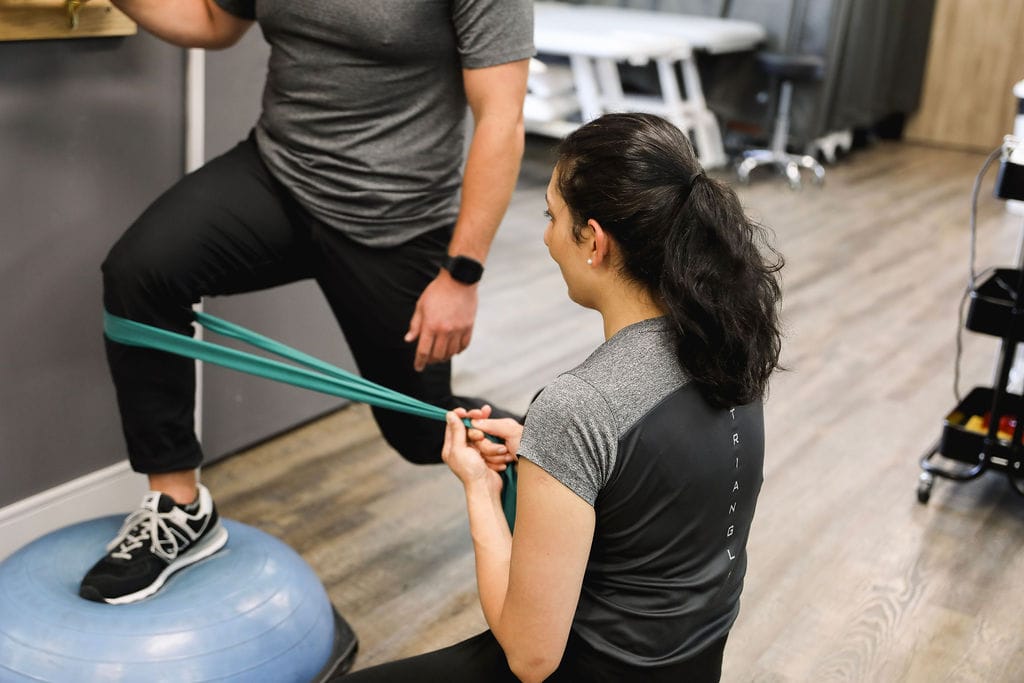
People often ask us if physiotherapy is the same as physical therapy, and the answer is yes. In fact, the term physiotherapy and physical therapy can almost be used interchangeably.
Are there any differences and similarities between physical therapy and physiotherapy?
In general, there are no differences between physical therapy and physiotherapy. The term physiotherapy is used for those based in Australia, Canada, or Ireland while the term physical therapy is used by those based primarily in the United States.
Some believe that there is a slight difference when it comes to its approach. Some would say physiotherapy uses more hands on approach and manual therapy while physical therapy is more exercise based in its approach.
Ultimately, it shouldn’t matter which term is used as long as you see someone who is registered with the College of Physiotherapists of Ontario. Find a professional who will provide you with the proper treatment and care to help you with your condition and improve the quality of your life.
At Physiotherapy Oakville, all our therapists are registered with the College of Physiotherapists of Ontario, ensuring you receive the highest standard of care. By joining Physiotherapy Oakville, you can trust that you are in capable hands, dedicated to helping you achieve optimal health and well-being. Connect with our expert team today to start your journey towards a better quality of life.
Similarities:
- Both Physiotherapy and Physical Therapy aim to help patients recover from injuries and conditions that affect their mobility and independence.
- Both professions use a variety of manual therapy techniques, exercises, and other treatments to help patients regain strength, flexibility, and range of motion.
- Both Physiotherapy and Physical Therapy are concerned with improving the quality of life for patients and helping them return to their daily activities as soon as possible.
Differences:
- Geographical Location: Physiotherapy is a term used primarily in the UK, Europe, and other parts of the world, while Physical Therapy is used primarily in the United States.
- Education: Generally, the education is no different for both titles.
- Scope of Practice: This may differ based on the country of practice but in North America the socpe remains the same.
- Specializations: Physiotherapists have the option to specialize in specific areas of practice. They can specialize in sports, women’s health, cancer rehab and pediatrics. Physical Therapists also have the option to specialize, but the options may differ depending on the country they practice in.
Our More Locations
Physiotherapy Etobicoke | Physiotherapy Oakville | Physiotherapy North York | Physiotherapy Toronto | Physiotherapy Lawrence Park | Physiotherapy Mississauga | Physiotherapy Queens Quay | Physiotherapy Mississauga Erin Mills | Physiotherapy Liberty Village
Book your appointment to see a physiotherapist here.
“While physiotherapy and physical therapy are often used interchangeably, both involve similar approaches to improving movement and reducing pain. Triangle Physiotherapy offers expert services across the GTA, including Physiotherapy in Etobicoke, Oakville, North York, Toronto, Lawrence Park, Queens Quay, Erin Mills, Mississauga, and Liberty Village. Our experienced team is here to provide personalized care tailored to your specific needs, whether you refer to it as physiotherapy or physical therapy.”
